The last of a thing is often a cause for nostalgia, even regret. The new thing may be objectively superior and hard to fault by the numbers. But something’s been lost, just the same.
And the thing will never be the same again.
Art deco-era steam locomotives. Big-gun battleships. Boeing 707s, turbines screaming.
And the last of the classic front-engined Ferraris, the 1968-73 Daytona 365 GTB/4 – aka the Daytona.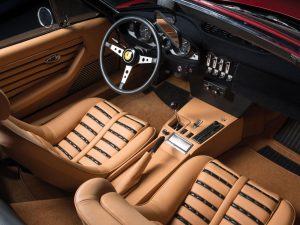
But not officially.
Ferrari never called it that – the name was bestowed by Ferrari aficionados in honor of the “triple crown” sweep of the 1967 24 hours of Daytona, also known as the Revenge of Il Commendatore – that is, of Enzo Ferrari – after the drubbing he had received the year prior at the hands of Henry Ford II, of all people.
Who had resources Ferrari lacked.
Ford was a huge operation, second only to GM in terms of money and manpower – and GM at that time owned half the entire North American car market.
In comparison, Ferrari was like a high school kid fooling around in his parents’ garage. A very talented kid, certainly. But talent-less-resources only takes you so far. Henry the deuce had resources in abundance and used them to develop the legendary GT 40. With which he dominated endurance racing, winning not only Sebring and Daytona but also the 24 Hours of LeMans – earning Ford the 1966 World Sportscar Championship trophy.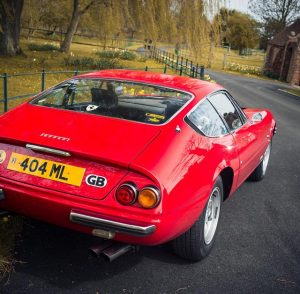
This, the dude – so to speak – could not abide.
Enzo pulled out whatever stops remained and came back the next year with an incredible 1-2-3 drubbing at Daytona – on Ford’s home turf – using V12s much smaller than the huge V8s which powered the GT40s, re-establishing the Italians as uno.
These Ferraris – 330 P4s – were “works’ cars, of course. That is, factory-prepped race cars. The 365 GTB/4 that made its international debut the following year at the Paris Auto Show was a street car. But the association with the victory over Ford stuck and the car became known more familiarly as the Daytona.
It is not only the last carbureted/front-engined V12 production car Ferrari ever made, it is in the opinion of many the finest Grand Touring supercar ever made.
It is certainly among the most beautiful.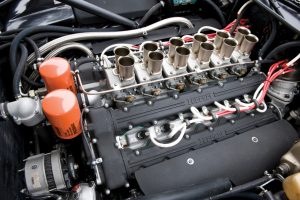
Classic long hood – to accommodate the longitudinally mounted 4.4 liter V12. Sharp, low roofline. A shove-nosed front clip with pop-up headlights (this to meet U.S. requirements, the original European version had fixed lights and translucent covers but these did not meet DOT standards; one of the few times that federal regs resulted in a car that looked better rather than worse). Side pillars and glass angled inward to meet the roof panel, with the effect that the fuselage looked like a jet fighter in the works.
Just add the wings.
Compared with the Ferraris that came later – including its successor, the mid-engined 365 GT4 Berlinetta – the Daytona was almost demure, if such a thing can be said of any Ferrari.
No gaping maws, airfoils or slats took away from the simple elegance of its form. There were twin reverse-facing ducts pressed discreetly into the Daytona’s hood – to help bleed off underhood air pressure at high speeds and perhaps provide some cooling effect as a side perk.
Delicate bumperettes framed the prancing horse, mounted almost inconspicuously in the low-set eggshell grille. The rake of the glass, just right.
Viewed from behind, you got a sense of the way the metal rolled to embrace the underlying chassis. It is one of those cars that does not need to move to move you. The Daytona’s perfection of form has been likened to what Botticelli might have created had he lived 400 years later and his metier been cold-rolled steel and hammered aluminum rather than canvas.
The Birth of Venus – on four wheels.
But it wasn’t Botticelli whose genius conjured the Daytona’s lines. Credit goes to Pininfarina – with coachwork handled by Carrozzeria Scagliettii, the company Enzo often commissioned to work up many of his now-famous race cars (notables include the 1958 250 Testa Rossa).
The original Daytona’s doors, hood and true lid were made of aluminum (later production cars had steel doors) and underneath that were hoop-style main structural tubes, braced as necessary.
The five-speed manual transaxle – no automatic was offered – was rear mounted, which balanced the weight of the V12 up front.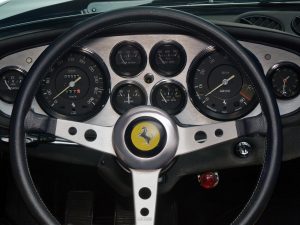
The result was a true high-speed GT, a car that was stable at speeds that were much iffier in other supercars of the time, including the also-gorgeous but dicey-at-speed Lamborghini Miura – notwithstanding that car’s nominally superior mid-engined layout.
In addition to being the last of the front-engined Ferraris, the Daytona was also the last of the V12 Ferraris . . . for the U.S., at least.
At least, for awhile.
The Clean Air Act of 1970 was making life hard on performance cars generally and Italian exotic performance cars particularly. Ferrari would revert to smaller engines for the rest of the ’70s and even into the mid-1980s – until the 1984 Testarossa brought the V12 back in smog-compliant form, fuel-injected and catalyst-equipped.
But in ’68, Ferrari could still get away with a V12 fed by six Weber 40 mm carburetors and exhaling through an exhaust not stifled by catalytic converters. To hear it sing was – and still is – like hearing Caruso perform Pagliacci.
It was an enlarged version of the Ferrari 275 GTB/4’s “Colombo” engine – named after its designer, Gioacchino Colombo. It was first produced in 1947 and originally displaced just 1.5 liters. It grew in size as the years went by, reaching 3.3 liters in the Daytona’s predecessor, the 275 GTB.
For the Daytona, the V12 was bored out to 4.4 liters – just under 270 cubic inches in American displacement-speak and so smaller in displacement than most American V8s of the same era. But it made up for its lack of piston displacement by moving immense volumes of air through its DOHC cylinder heads.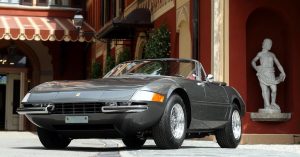
It was a narrow-angle (60 degree) engine, with a comparatively short (2.8 inch) stroke that made it born to rev. The redline was 7,700 RPM and peak power was produced just below that, at 7,500.
Compression was a relatively low 8.8:1 for the U.S. version (it was slightly higher in Europe) which made it feasible if not optimal to run the thing on unleaded regular gas without risking potentially catastrophic detonation in those pre-knock-sensor days. But it did its best work when fed premium leaded. The result was a smell at the quad pipes out back as delicious to the aficionado’s nostrils as the bouquet of a fine wine to the sommelier’s.
Maximum output was 352 hp and 318 ft.-lbs. of torque.
These may not seem particularly impressive numbers by modern standards, but one must take into account how light the Daytona was – especially for a GT. Though it had about the same overall footprint as a current (2017) Corvette, it weighed just 2,646 lbs. vs. about 3,200 lbs. for Chevy’s modern supercar – which has the nominal advantage of composite body panels, even lighter than the Daytona’s mostly aluminum skin.
But the ‘Vette is much heavier under its skin because of the need to pass muster with the panoply of modern bumper impact, rollover/roof crush and other such standards – which the Daytona’s designers never had to worry about.
The 365 wasn’t as quick as a new Corvette – but it was nearly as fast.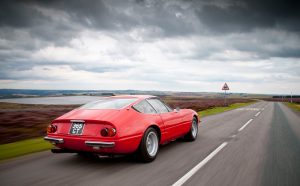
The former – acceleration from a standstill, zero to 60 especially – being as much a function of traction as horsepower. And the Daytona, like all the powerful cars of its time, lacked traction. This V12 supercar came from the factory with 15×7 “star” wheels mounting P215/70-15 tires, insufficient to corral the 4.4 liter V12’s horses, particularly from rest.
A current-year FWD economy car – for a instance, a Toyota Corolla – has rolling stock about the same size (if not slightly wider and grippier) than what the Daytona had to work with. And the current Corvette has 18-inch wheels up front and 19-inch wheels out back, mounting P285/35 series rubber. More contact patch than the Daytona’s 330 P4 race car siblings that won Daytona had to work with.
And of course, the Daytona – a child of the ’60s – had no traction control or launch control, either – both of which the Corvette has.
No wonder the new ‘Vette is quicker.
But faster is another story.
A stock (unmodified, as it came from the factory) Daytona was a 180 MPH car – haltingly fast in 1968 and still damned fast today, almost 50 years after the fact. A brand-new Corvette is no faster, or only slightly so – maybe. Even with all the advantages of its modern enhancements.
And notwithstanding its skinny tires, the Daytona was safe to operate at the speeds it was capable of attaining – assuming you had the nerve to venture there. Car & Driver legend Brock Yates and racing legend Dan Gurney took a Daytona across America at such speeds, winning the also-legendary and notoriously not-legal Cannonball Baker Sea-to-Shining-Sea Memorial Trophy Dash in 35 hours and 54 minutes.
Gurney promised he’d “never once exceeded 175 mph.”
The Daytona’s top speed record stood for years. And largely still stands in that there are only a small handful of factory stock production cars available today that can exceed 180 MPH.
That is something.
Almost all Daytonas were Berlinettas – hardtops, in Ferrari-ese – but there were a few factory convertibles, or 365 GTS4 Spiders, in Ferrari-ese. Scaglietti performed the work, which involved welding in cowl supports and other such to make up the structural rigidity lost by losing the fixed roof, which otherwise tied the whole together.
Very few of these were made, however. Or rather, very few were made by Scaglietti/Ferrari. Mosts sources say 122 – the others being chop-jobs done by various unauthorized shops, mostly during the 1980s as the result of a fake Spider guest-starring (along with Don Johnson) on the popular TV show, Miami Vice.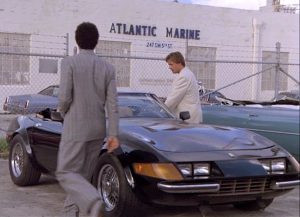
That car wasn’t even a Daytona. (The square headlights are an obvious giveaway.)
It was re-bodied Corvette. Ferrari considered this an insult to the real Daytona’s legacy and sued the show’s producers for trademark dilution. This is the real reason why the ersatz Daytona/pseudo-Spider was literally blown up on camera toward the end of the show’s second season.
It was replaced the next season by a real Ferrari Testarossa – generously provided by Ferrari.
No one – not even Ferrari – makes a car like the Daytona anymore. Because cars like the Daytona have been effectively outlawed and not merely because of the Smog Police. Modern Ferraris prove that an EPA-compliant V-12 is possible. But the Renaissance elegance of the 365 GTB/4 shall not pass this way again because the delicacy of such form has been effectively outlawed by the Safety Nazis, who eschew beauty for the sake of girder-like windshield pillars to support a turn-turtle roof and clumsy-looking but crashworthy noses and tail-ends.
No more wing vent windows; no more being able to see what’s going on around you. Plenty of air bags, though.
What they have done to cars is not unlike putting sweat pants on Venus.
These wreckers have ruined our time. But the Daytona is physical proof – like Botticelli’s Venus – of an earlier and better time.
…
Daytona Trivia:
- The Daytona was the last Ferrari designed prior to Fiat acquiring control of the company in 1969.
- Road & Track magazine declared the Daytona the “best sports car in the world.”
- In addition to the Spider convertibles, there were also a handful of 2-plus-2 versions of the Daytona.
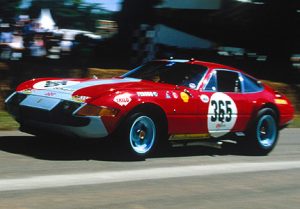
- Several race iterations were made, most at Ferrari’s Assistenza Clienti facility in Modena. There was also an all-aluminum race car made for Luigi Chinetti’s racing team. These cars had chin spoilers and widened wheelwheels to accommodate larger tires.
- All Daytona V12 featured dry sump oiling for racing – and an air-injection system to meet American emissions standards.
- Approximately 1,284 Daytona coupes were made over the car’s five-year production run. Another 122 Spider convertibles were also made, these becoming officially available – from Ferrari – beginning in 1971. These are the most coveted of Daytonas due to their extremely low production, which accounts for the fairly large number of converted convertibles. Some of these are so well converted that it’s difficult to tell whether the car was originally a hardtop or . . . not. Caveat emptor.
- Current market value of a Daytona coupe is the range of $650,000 according to Hagerty, a well-known insurer of collectible cars. The value of a legitimate Spider runs to about twice that.
Excerpted from Eric’s forthcoming – eventually – book, Doomed.
. . .
Got a question about cars – or anything else? Click on the “ask Eric” link and send ’em in!
If you like what you’ve found here, please consider supporting EPautos.
We depend on you to keep the wheels turning!
Our donate button is here.
If you prefer not to use PayPal, our mailing address is:
EPautos
721 Hummingbird Lane SE
Copper Hill, VA 24079
PS: EPautos stickers are free to those who send in $20 or more to support the site. Also, the eBook – free! – is available. Click here. Just enter you email in the box on the top of the main page and we’ll email you a copy instantly!


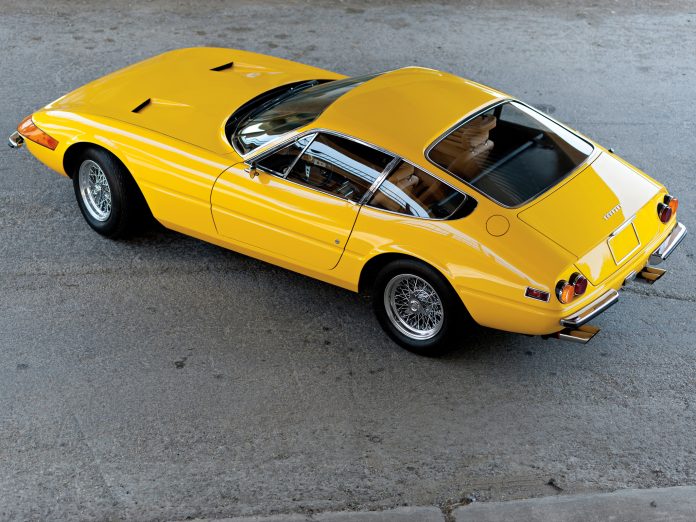









ironically they used a real daytona in the pilot of miami vice. Such a beautiful car. I much prefer the four eyes headlight look to the retractable ones. micahel Mann had such an eye for style. When miami vice lost him after season two – and the daytona – it pretty much was all downhill. Btw – Mann had reall daytona engine sounds recorded over the corvette sounds in the episodes following. https://www.youtube.com/watch?v=qSARDlHh-Mg&ab_channel=StefanVergu
Ahhh…the memories.
The first one I saw was when I caddied at an all men’s golf course. You knew when that member was coming to play a round…you could hear the rumble a mile away. It never got louder, only closer.
The best was when I got a ride in a competition model at Charlotte Motor Speedway roval. Coming out of the infield and on the the banking at the base of Nascar T1 the driver stood on it, the nose rose slightly and the sound and fury was like nothing I’ve ever experienced before or since…I think I need a cigarette.
Hi Mark,
You lucky dog!
I have never had a chance to drive one on a track; just a drive around the block. Still, a slice of heaven. I would almost trade my house for one of these… except it would only be enough for the downpayment…
SCCA runs Track Night in America. It’s a “run what you brung” kind of event. If you have a roof or factory roll-over protection you can get on track. I’m sure with all the cars you get to test it might be interesting to bring one of those…
https://www.tracknightinamerica.com/
Autocar reckoned the standard Daytona was a 174 mph car. A tuned one in New Zealand managed 186 mph one way, but it was somewhat non-standard and it was one of the lightweight ones. It was a red car with the fixed headlights (not the pop-ups). I remember it well. You avoid 2nd gear until the transmission is warm (trans is in back, so it takes a little bit extra time for it to warm up). Cruising on the motorway is done with the engine at 3,500 rpm or more (it is like a motorcycle in that it likes rpm). The owner’s book instructs you to select an intermediate gear to keep the engine in the 3k rpm range at cruise. It sounds brilliant and it sure responds well to the throttle pedal. It does not like to be lugged at lower rpm although it remains well mannered if you must do this to it. Best not to. Steering is on the heavy side, at least until you get the speeds up. I recall it was not a car that liked to have sudden mid-corner changes of line. You guide it round the bends. It goes round them very securely and quickly. It pretty much goes everywhere at 120mph. That’s about the natural cruise speed of the thing. One last point- it is not a sports car really, it is a grand tourer and a very good one at that.
I’m trying to figure out how it took almost 36 hours for a 180 mph car to win the cannonball baker dash — when google maps shows it is possible to complete the same route in 42 hours at what I assume are legal speeds.
Even allowing for about 10 stops to gas up for the 2,850 mile run, that only adds about an hour.
Remember, this was the early 1970s without as complete an Interstate system as we have today, cars that were not as reliable, and fewer resources thrown at the race initially. On the plus side, police were easier to evade and fewer in number/enforcement of speed limits.
The most current record I can find from lower Manhattan to Redondo Beach, CA, is 26 hours, 28 minutes in a highly modified 2014 Infiniti Q50 (of all things). Apples to apples and you’re looking at 16 hours shaved off legal speeds today. Back then it wouldn’t have been a 42 hour cross country trip but probably closer to 50 hours.
Am I missing somthing here? Ferrari has been building front engine V12 cars since ’95 with the 550.
He means (and says) the last Carbureted, Front-Engined, V12, Ferrari. All V12s sold in the US after that one were fuel-injected. That’s pretty specific, but meaningful.
Great article.
I know it all depends on where one lands on the generational time spectrum. But to me, this 365 GTB, in the context of the Yates/Gurney “Sea to Shining Sea” land record, is the most iconic, legendary car….EVER!
And from my perspective, that achievement also may have been the High Water mark for “America.”
Beautiful car from the edge of the golden era of the motor car. I also like how Eric got a dig in for the Boeing 707. The 4 engine mid sized planes were a sight to behold.
Thanks, Swamp!
I can remember seeing 707s fly into JFK as a kid… and later, the Concorde… those four magnificent Olympus engines…
The golden age of flying ended when the last commercial domestic flight of the Boeing 707 took place in the United States. It seems as if the 73-74 energy embargo slowed the orders for more than twin engine aircraft. I remember the dark brown smoke that you could see emitting from the loud J79 turbojet engines. I used to live near NYC in CT. When we went to Kennedy you could smell the aromatic JP5 in the tank farm around the airport. Those were great years.
Top Notch.
Peters Elite Autosports C7 Corvettes
https://www.youtube.com/watch?v=NW1QK9P-DDc
Start the ’55 Plymouth Savoy and enjoy the coordinated symphony of movement between your left hand on the steering wheel….your right hand maneuvering the h-pattern of the “3-on-the-tree” lever…your left foot on the clutch pedal… while your right foot controls the mechanical linkage connected to a carburetor. And the brake.
Engine seems warmed up. Push the choke knob in.
It sometimes grinds when going into first gear or reverse, but smooth as silk into 2nd and 3rd. Who invented a synchronizer anyway? At least there is no “granny gear”.
Get out of the Savoy, and pre-flight the 150. The dual mags check okay during the run-up. Carb heat is working.
Field is quite short. Better give it 10 degrees of flap for takeoff. Sectional is on my lap and the Savoy is getting smaller and smaller.
Land this thing and time to enjoy a shot of Beam.
Why does Red Adair make me feel so inadequate?
Go read some more of that Peters guy.
Great read,thanks Eric
Thanks, Anon – my pleasure!